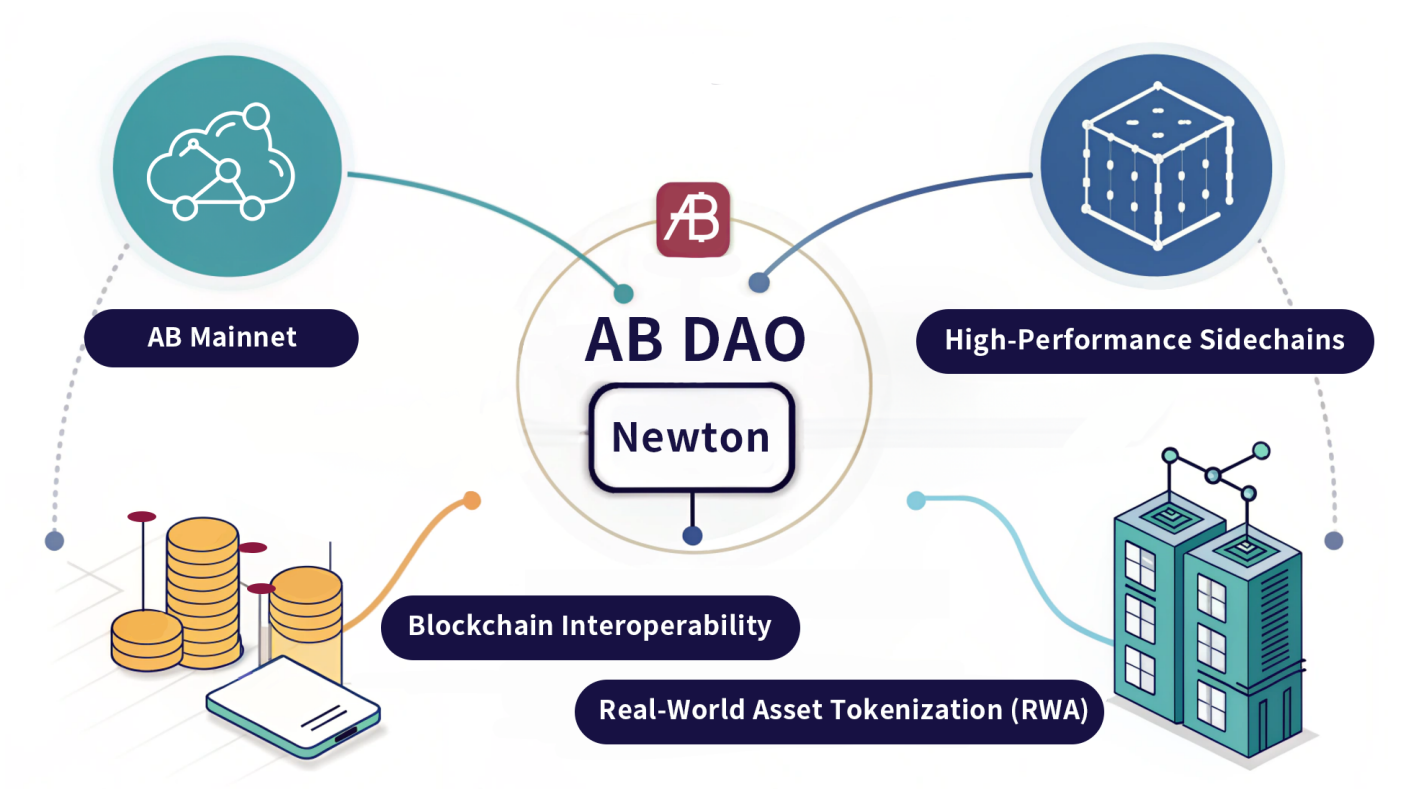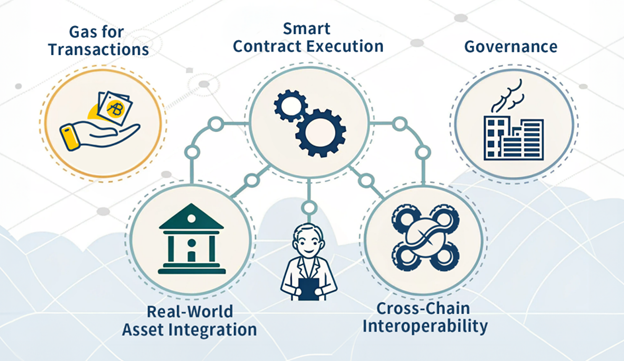AB (AB): Scaling blockchain for real-world adoption
In the constantly changing landscape of blockchain technology, projects have to evolve and adapt in order to remain competitive and relevant in the space. One such project that has continued to evolve is AB, which rebranded from Newton Project in February 2025.
Within a month of its rebranding, AB continued on a price rally that saw the AB token hit its all-time high (ATH) price of $0.017 on Mar 22, 2025.
The Newton Project began in 2018 with the vision of creating a community economy whose members would benefit from the project's growth.
Now, with the rebranding to AB, the project has shifted into building a broader and more advanced blockchain ecosystem that includes real-world asset (RWA) integration and optimized tokenomics.
Let’s learn more.
Key Takeaways:
AB (formerly Newton Project) provides an advanced blockchain network that enables real-world asset (RWA) tokenization and cross-chain interoperability.
Its key features include a mainnet and sidechains designed to ease congestion, thus leading to improved scalability.
Its native token, AB, facilitates transactions, governance and the tokenization of RWAs.
What is AB crypto?
AB is a heterogeneous and interoperable blockchain network designed to help bridge the gap between digital and real-world economies. The project builds on the vision of the Newton Project, which was started in 2018 to provide a community-focused blockchain economy centered on decentralization.
The rebranding of Newton to AB signifies a shift toward empowered decentralization, enhanced liquidity, more real-world adoption and better interoperability.
AB’s main features
With its shift, AB has developed a more advanced architecture with the following innovative features to cater to the dynamic needs of web3.
AB MainNet — AB’s mainchain acts as the core framework of its ecosystem. The MainNet facilitates smart contract execution, swift processing of transactions and decentralized governance. It's designed to accommodate the versatile needs of developers and crypto users.
Sidechains — AB has also created sidechains to cater to the specific needs of different industries. The primary purpose of these sidechains is to ease congestion on the MainNet, leading to scalability and more efficiency.
Interoperability — AB is built to facilitate cross-chain communication between blockchains, ensuring seamless asset transfer and leading to better collaboration and connectivity.
RWA tokenization — RWAs can be tokenized on AB to make them tradeable on blockchains. This feature makes the technology widely available, thus leading to increased adoption, especially in industries such as real estate and finance.
AB DAO
AB's decentralized autonomous organization (DAO) empowers AB token holders to actively participate in the project's governance. Token holders can propose and vote on key decisions, including network upgrades, economic parameters and strategic initiatives, ensuring the ecosystem remains community-driven.
All governance actions are recorded on-chain, thereby promoting transparency and accountability. This decentralized model fosters trust and aligns the project's evolution with the interests of its community.
AB Wallet
AB Wallet is a decentralized digital wallet, developed by the AB Foundation, that’s designed to support multiple tokens with an emphasis on speed and security. It serves as the official wallet for the AB Community Economy, allowing users to manage their digital assets efficiently. The wallet is available for download on the App Store, and as an APK for Android devices.
NewBridge, which is integrated within the AB Wallet, is a cross-chain platform developed by the AB Core Team that facilitates the transfer of assets across different blockchains. It enables users to move assets such as WBTC, USDT and ETH between Ethereum and NewChain securely and efficiently.
Developers can also utilize NewBridge's APIs to create decentralized applications (DApps) with cross-chain capabilities.
How does AB crypto work?
AB operates at a more advanced level than its predecessor, the Newton Project, while remaining true to the vision of a community-focused blockchain economy.
Central to AB's operations is its MainNet (formerly known as New Chain in Newton). This public blockchain is fast and scalable, with a rate of 5,000 transactions per second (TPS). It uses a proof of authority (PoA) consensus mechanism that entrusts several pre-approved validators with the security and validation of transactions on AB’s network.
Above the MainNet, AB's Hyper Exchange Protocol is designed to provide technical support to business DApps by delivering real value. This technology layer supports various features, such as supply chain, digital and credit identity, payments and self-finance. One of AB's first applications powered by this technology is New Mall, an e-commerce store that leverages blockchain technology.
With the rebranding, AB introduced sidechains to ensure optimized functionality on AB, which leads to scalability and better efficiency.
AB also enhances the Hyper Exchange Protocol's real-world utility by facilitating the tokenization of RWAs into blockchain tokens on its network. This makes it easier to trade these assets, which leads to more adoption.
What is the AB token?
The AB token (formerly NEW) is the native cryptocurrency of the AB crypto project. Its various use cases include the following:
Gas token — AB drives transactions within the AB network, facilitating the transfer of digital assets and powering the interaction of DApps.
Execution of smart contracts — Developers need AB tokens to deploy and execute smart contracts on AB’s MainNet.
Governance — AB token holders can participate in AB's governance by voting on its DAO. They can submit proposals, vote on existing proposals and contribute to the network's growth.
RWA tokenization — AB tokens facilitate the tokenization of RWAs into the blockchain, leading to broader adoption.
Cross-chain interoperability — AB tokens can be used across multiple supported chains within AB’s ecosystem.
As of Apr 1, 2025, AB was trading at $0.015, which is a 13.1% drop from its ATH of $0.017 on Mar 22, 2025, and an increase of almost 400,000% from its ATL of $0.0000038 on Oct 11, 2022.
AB has a total supply of 100 billion tokens, with a circulating supply of approximately 50 billion. With the rebranding, AB has revised its tokenomics to promote liquidity and incentivize participation in the network.
With the updated token distribution model, 56.6 billion AB tokens were locked as of February 2025. These tokens will be released monthly over a period of 12 months, and will be fully in circulation by February 2026.
Also, from February 2025, token incentives were made exclusive to machine node operators on the MainNet and sidechains. However, the project is exploring ways to incentivize AB token holders in the future through staking and on-chain lending.
Closing thoughts
AB marks a significant evolution in blockchain technology, rebranding from the Newton Project to better align with its vision of real-world adoption. By leveraging the AB MainNet, high-performance sidechains and cross-chain interoperability, AB is positioning itself as a scalable and efficient blockchain ecosystem.
With use cases spanning finance, gaming, supply chain and asset tokenization, AB enables seamless integration of blockchain tech into everyday applications. Its decentralized governance model via the AB DAO ensures transparency and community-driven innovation. As AB continues expanding its ecosystem, it stands to drive mainstream blockchain adoption, providing traditional industries with a bridge to web3 solutions.
#LearnWithBybit



